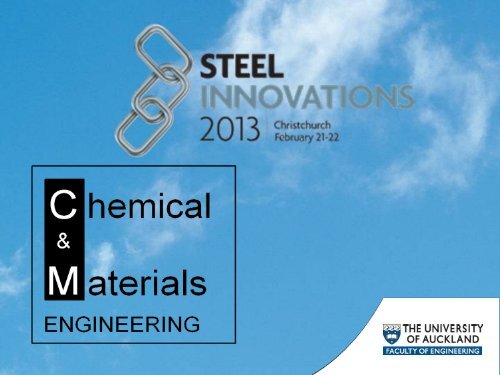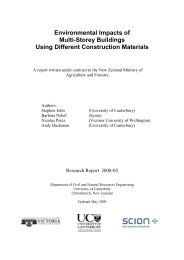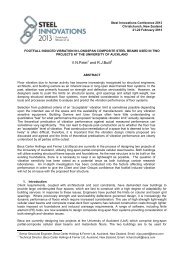Paper 9.1 - Steel Innovations Conference 2013 Christchurch-Ver4.pdf
Paper 9.1 - Steel Innovations Conference 2013 Christchurch-Ver4.pdf
Paper 9.1 - Steel Innovations Conference 2013 Christchurch-Ver4.pdf
You also want an ePaper? Increase the reach of your titles
YUMPU automatically turns print PDFs into web optimized ePapers that Google loves.
The Performance and Remnant Life of Structural<br />
<strong>Steel</strong> in an Earthquake Damaged Building<br />
W. G. Ferguson 1 , H. Nashid 2 , G.C. Clifton 3 ,<br />
M V Kral 4 , S. Lopert 5 and G MacRae 6<br />
PART A<br />
W. George Ferguson<br />
Department of Chemical & Materials<br />
Engineering
Pacific Tower<br />
<strong>Steel</strong> Framed Building<br />
22 Storied<br />
Eccentrically Braced Framed<br />
(EBF) Seismic resisting system
Eccentrically Braced Frame (EBF)<br />
K - Type
Earthquake Resistant Construction<br />
• <strong>Steel</strong> framed structures performed well during the <strong>Christchurch</strong><br />
• Inelastic/plastic deformation was less than predicted<br />
• A design philosophy is to have structural elements (eg. EBFs’)<br />
deforming plastically and absorbing energy<br />
• Some EBFs’ sustained significant plastic deformation<br />
• How much more plastic strain can these elements absorb?<br />
• The question is “to replace the deformed EBF or not to replace the<br />
deformed EBF” that is the question?<br />
• This aspect is examined in the Pacific Tower
Structural <strong>Steel</strong><br />
• 153 years since Bessemer set up a <strong>Steel</strong> Company in Sheffield<br />
• <strong>Steel</strong> more plentiful, less expensive and available for structures<br />
• Open Hearth method used for higher quality steel<br />
• Electric Arc and Oxygen processes are modern methods<br />
• Late 1800’s, maximum limits for phosphorous, P, & sulphur, S<br />
• Early 1900’s impact tests for toughness in use<br />
• After WWII increased weldability important<br />
• Also need for increased strength, ductility & toughness
Modern Structural <strong>Steel</strong><br />
• Strengthening structural steel by<br />
- grain refinement (reduce size)<br />
- solid solution strengthening<br />
- precipitation hardening<br />
• Increase Toughness & reduce Transition Temp. by<br />
- grain size reduction<br />
• These achieved by Al treatment, addition of micro-alloying<br />
elements, Nb, V & Ti together with controlled rolling.
Lamellar Tearing – RBNZ 1974<br />
Sulphur reduction & inclusion shape control<br />
• Beam-Column Joint doubler plate weld doubler plate<br />
•<br />
Weld HAZ Fracture Surface
AS/NZS 3678:2011 Structural <strong>Steel</strong> (plates & slabs)
Certificate of Analysis and Mechanical Test
Plastic Strain Determination<br />
Determine plastic strain in a deformed Structure<br />
• Strain gauges and extensometers – when deforming<br />
• Digital imaging – no pattern on beam<br />
• Magnetic Barkhausen Noise – not developed<br />
• Hardness Test – material must work harden<br />
- Rockwell & Leeb (portable) Hardness Testers<br />
- Hardness tests show scatter<br />
- Method has established use in Nuclear Industry<br />
- <strong>Steel</strong> deformed to various plastic strains<br />
hardness measured<br />
hardness correlated with either strain or flow stress
Hardness Technique<br />
Grade 300Mpa steel<br />
Tensile specimens<br />
Plastic strained<br />
Rockwell B hardness
Rockwell B Hardness – Plastic strain<br />
Correlation
EBF – Web Plastic Strain<br />
- testing zones A B, & C<br />
- tensile specimen locations<br />
- hardness test grid pattern for zones A, B & C
Rockwell B versus Grid Numbers<br />
for Zones A, B & C ( Leeb tester)
Hardness versus Normalised Beam Depth<br />
for Zones A, B & C (Rockwell & Leeb testers)<br />
Note: - for zones B & C plastic strain near flanges<br />
- for zone A plastic strain constant across web
Stress – Strain Curves<br />
for zones A, B & C<br />
- tensile test results confirm hardness behaviour<br />
- as received plastic strain near flanges of about 3%<br />
- active link, zone A, plastic strain about 7 – 7.5%
- paint peeled off centre of web<br />
- plastic strain in centre of web<br />
Active Link
Beam X–Section Hardness Traverse<br />
- results Tide 16<br />
- as received plastic strain caused by cold flange straightening
Toughness of Pre-strained <strong>Steel</strong><br />
• <strong>Steel</strong> 310UC158 G300+<br />
Specimens taken from<br />
25mm thick column flanges<br />
• <strong>Steel</strong> pre-strained in<br />
uni – axial tension<br />
– 4.9%, 9.8% & 17.7%<br />
• Specimens prepared from<br />
pre-strained material for:<br />
Charpy V-Notch CVN,<br />
tensile and CTOD, testing at<br />
various temperatures.<br />
• Naturally Aged for at least<br />
2 months<br />
C Mn Si S P Ni V Nb Ti Al N<br />
0.17 1.47 0.10 0.014 0.017 0.007 0.001 0.001 0.001 0.025 0.0064<br />
Table 1 Mill certificate chemical analysis of 300Plus 310UC158, wt-%
Charpy V – Notch Transition Curves<br />
- effect of plastic prestrain<br />
- transition temperature increases with increasing prestrain
Conclusions<br />
• Need knowledge of Standards & <strong>Steel</strong> Mill Certificates<br />
• Hardness technique for determining plastic strain is credible<br />
• Portable Leeb hardness tester can give consistent results<br />
• The hardness variations in EBF link confirmed by tensile tests.<br />
• Testing must be done in the centre of the beam web<br />
• There was about 7 – 7.5% plastic strain in the active link beam.<br />
• Pre-existing plastic strain near the flanges produced by low<br />
temperature roll straightening of the flanges - strain was about 3%.<br />
• <strong>Steel</strong> plastically deformed 7.5% would still just meet 70 J at 0˚C
Thank you
Tensile Properties<br />
-at 10˚C<br />
- significant increase strain aged yield stress<br />
4.9 %<br />
9.8%<br />
17.7%

















